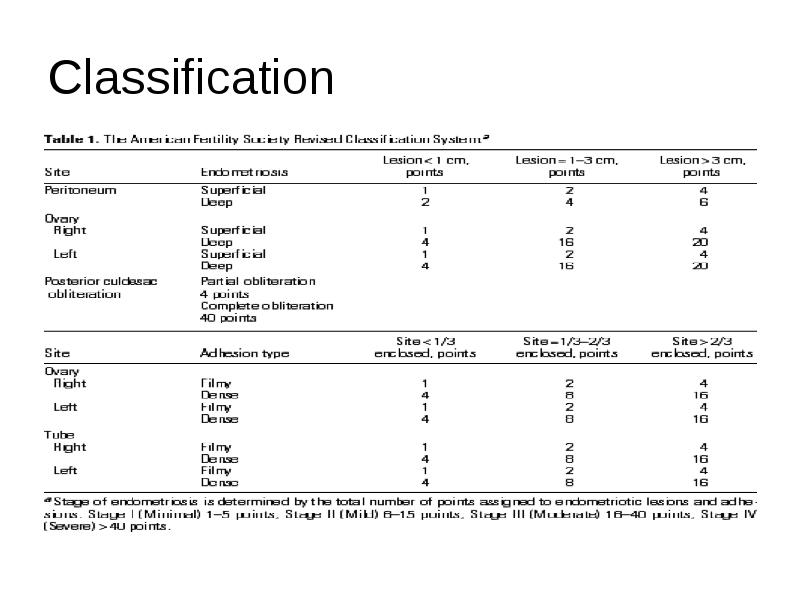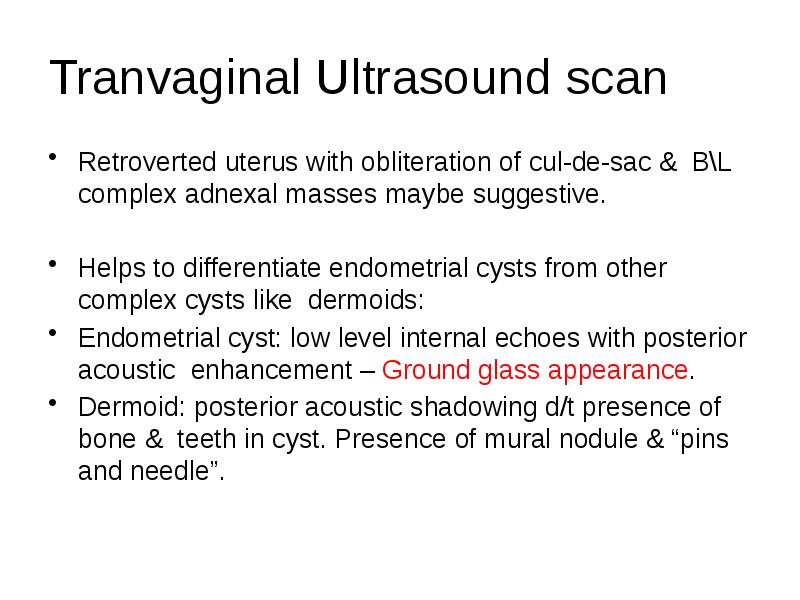ENDOMETRIOSIS презентация
Содержание
- 2. ENDOMETRIOSIS INTRODUCTION OF ENDOMETRIOSIS SITES AETIOLOGY THEORIES FOR ENDOMETRIOSIS CLINICAL FEATURES
- 4. INTRODUCTION Endometriosis initially described by Von Rokitansky in 1860 Endometriosis
- 5. SITES ABDOMINAL Most common site -
- 7. EXTRA-ABDOMINAL EXTRA-ABDOMINAL Common sites - Abdominal scar
- 9. AETIOLOGY Age - 30-40 years(most common) - between the menarche and
- 10. Theories for Endometriosis Retrograde menstruation (Sampson’s theory) Metaplasia of coelomic epithelium
- 11. Retrograde menstruation ( Samson’s Theory) John Sampson first postulated that endometriosis
- 13. Coelemic metaplasia( Mayer And Ivanol) In this theory, the germinal epithelia
- 14. Lymphatic Theory (vascular theory ) Endometrial cell can be transported to
- 15. Genetic factors The risk or endometriosis is 7 times greater if
- 16. Autoimmune theory In cellular immunity, can facilitate the successful implantation
- 17. Induction theory The induction theory is, in principle, an extension
- 18. Inflamation Substantial evidence suggests that endometriosis is associated with a
- 19. Pathophysiology Endometriosis is an estrogen-dependent condition. Estradiol concentration greater than 60pg/ml
- 20. Increased concentration of macrophages derived growth factors including vascular endothelial growth
- 21. Sign &Symptoms SIGNS Tenderness in cul-de-sac Nodularity in cul-de-sac Fixed retroverted
- 22. Clinical Features Symptoms: Pelvic- Dysmenorrhea(50%) Abnormal menstruation(60%)
- 23. Dysmenorrhea Most common symptom Pain starts a few days prior to
- 24. Dyspareunia It is usually deep, due to stretching of the structures
- 25. Infertility Present in majority of the women with endometriosis. Advanced disease,
- 26. Diagnosis Recommended that pelvic examination be performed at the time of
- 27. Bimanual Pelvic Examination Examination On bimanual pelvic examination, fixed retroverted uterus,
- 28. Classification
- 30. Diagnosis Investigations Laparoscopy: Gold standard It should not be performed within
- 31. Diagnosis MRI
- 32. Diagnosis Histological Confirmation: Visual inspection is usually adequate but histological confirmation
- 34. Diagnosis Laparoscopy (Sensitivity : 97%, Specificity 95%) Types of lesions on
- 37. LAPROSCOPIC IMAGES : A )OLD ENDOMETRIOSIS (Blue/Grey) B ) OLD ENDOMETRIOSIS (Red)
- 38. Tranvaginal Ultrasound scan Retroverted uterus with obliteration of cul-de-sac & B\L
- 40. CA-125 Increased in moderate to severe endometriosis Also increased in non-mucinous
- 41. Extensive Pelvic Endometriosis
- 42. Dense Adhesions
- 43. Diagnosis Sonographic Features : Endometritic cysts (oval or round)- capsulated, fine
- 44. Differential Diagnosis Chronic PID Postoperative adhesions Old ectopic gestation Pelvic
- 46. Drug Treatment Combined oral contraceptives: Administered intermittently or continuously. High
- 47. Drug Treatment Danazol A synthetic derivative of ethinyl testosterone, Mildly
- 48. Drug Treatment Gonadotropin releasing hormone: GnRH is administered continuously to
- 49. Minimal Invasive Surgery Aspiration of peritoneal fluid in cul-de-sac. Destruction of
- 50. Minimal Invasive Surgery Role of surgery: u Failed Medical therapy
- 53. Surgery Indications for surgery: Advanced stage of disease detected Large lesion
- 54. Surgery Laparotomy: In advanced & larger lesions if medical therapy
- 55. Combined Therapy Preoperative GnRH: monthly for 3 months reduces size
- 56. Prophylaxis Low-dose OCP reduce the menstrual flow & protect against endometriosis.
- 57. THANK YOU
- 58. Скачать презентацию

























































Слайды и текст этой презентации
Похожие презентации





























